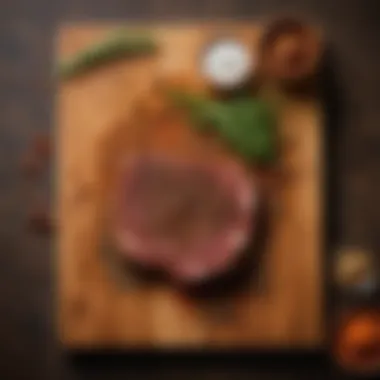Understanding Ranch Dry Rub: Its Composition and Uses


Intro
Ranch dry rub combines a variety of spices and seasonings that elevate food beyond the ordinary. Its unique flavor profile has made it popular among grilling enthusiasts and home cooks alike. This article explores its components, uses, and the cultural significance behind this seasoning blend. Understanding ranch dry rub involves looking into its ingredients, how they combine to enhance dishes, and the history that brought it to popularity. This exploration aims to give food lovers insight into how to effectively use dry rubs in their culinary practices.
Recipe Overview
Recipe name
Ranch Dry Rub for Grilling
Brief description of the dish
This ranch dry rub is designed for grilling meats, particularly chicken and pork. It offers a balanced mixture of tangy, savory, and herby notes, creating a robust flavor that transforms simple cuts of meat into delicious entrees. The application of this rub can also extend to vegetables, enhancing their taste and making them an attractive side option.
Ingredients List
Main ingredients
- Dried buttermilk: Provides a creamy and tangy flavor, foundational to the ranch flavor.
- Garlic powder: Adds depth and an aromatic quality.
- Onion powder: Complements garlic with sweetness and adds body.
- Dried dill: Infuses a fresh and herbaceous note.
- Black pepper: Introduces heat and complexity.
- Salt: Essential for enhancing all other flavors and providing balance.
Optional ingredients
- Paprika: Offers sweetness and a hint of smokiness.
- Cayenne pepper: For added heat and spice.
- Brown sugar: To create a sweet, caramelized crust when grilled.
Culinary Applications
The primary application for ranch dry rub is grilling, where it can be generously applied to meats such as chicken, pork, or beef. The rub is typically massaged into the meat, allowing the spices to adhere and penetrate. It can be used as a dry brine, allowing proteins to retain moisture during cooking.
Ranch dry rub also finds its way into various cooking methods, including smoking and baking. When used for smoking, the white pepper and garlic can blend perfectly with the wood smoke, enriching flavor. Baking traditionally calls for seasoning food ahead of time, and this rub can offer an appealing taste profile to roasted dishes.
"A well-made dry rub can change the eating experience entirely, drawing out natural flavors and adding layers of taste.”
Culmination
Understanding ranch dry rub means grasping the elements that make this seasoning powerful. Its ingredients, whether mandatory or optional, come together to create a unique flavor that can be applied to a wide variety of dishes. By incorporating ranch dry rub in your culinary practices, the potential to elevate your meals is significantly enhanced.
Prolusion to Dry Rubs
The concept of dry rubs is essential in the culinary world, particularly in relation to enhancing the flavors of grilled and roasted meats. Dry rubs are blends of various seasonings that are applied to food before cooking. They serve multiple purposes, including flavor enhancement, moisture retention, and creating a desirable crust or bark on the meat. For any food lover or culinary enthusiast, understanding dry rubs opens a door to a realm of flavor and technique that can elevate their cooking.
Some benefits of using dry rubs include:
- Flavor Concentration: Dry rubs allow for deep penetration of flavors into the protein, enhancing the overall taste.
- Texture Improvement: When cooked, the spices form a crust, giving both texture and appearance that adds to the dish.
- Customizability: They can be easily tailored to personal preferences, allowing cooks to experiment with different spice combinations.
Consideration around dry rubs should include choosing high-quality spices, the right proportion of ingredients, and an understanding of how to apply them effectively. Knowledge about dry rubs provides a solid foundation for anyone looking to sharpen their culinary skills and explore new tastes.
Definition of Dry Rubs
A dry rub refers to a mixture of seasonings that is used to coat meats, poultry, or vegetables prior to cooking. Unlike marinades, where liquid is involved, dry rubs rely solely on dry ingredients. These typically include various spices, herbs, and sometimes sugar. The application technique is straightforward; the rub is massaged into the food to ensure even distribution. The result is a more flavorful and aromatic dish.


Common dry rub ingredients include:
- Paprika
- Garlic powder
- Onion powder
- Black pepper
- Brown sugar
- Various herbs like thyme or oregano
The balance of these components dictates the final flavor profile.
Historical Context
The use of dry rubs has a long-standing history in various cultures, particularly in regions known for their barbecue and grilling traditions. The practice can be traced back to ancient times when people utilized spices for preservation and flavoring of meats. Various indigenous tribes across the globe have employed techniques similar to dry rubs, enhancing the natural flavors of their provisions.
In the United States, the regional barbecue variations such as Texas, Kansas City, and Memphis have popularized unique dry rub recipes. Each region tends to favor particular spice combinations, reflecting local tastes and available resources.
The growth of dry rub applications has also been influenced by modern culinary trends. For instance, the rise of outdoor grilling and smoking has introduced a broader audience to the benefits of using dry rubs. As people explore new cooking methods, their appreciation for the complexity and versatility of seasonings has expanded, cementing dry rubs as a staple in many kitchens today.
What is Ranch Dry Rub?
Ranch dry rub holds a key position in the culinary landscape, distinguishing it from other spice blends through its unique flavor profile and composition. This blend offers versatility in application, particularly when it comes to enhancing meats and vegetables. It serves not just as a flavor enhancer, but also as a way to elevate the food preparation experience in various cooking techniques, including grilling, baking, and smoking. Understanding this rub allows cooks to utilize it strategically, marrying flavor innovation with traditional methods.
Origins of Ranch Flavoring
The ranch flavoring can be traced back to the American West, where ranch dressing emerged as an iconic condiment in the 1950s. This creamy dressing, which includes herbs, buttermilk, and garlic, was originally crafted as a way to accentuate simple dishes. Over time, chefs and home cooks recognized the potential of the seasoning behind ranch dressing. Thus, from its rustic origins came the dry rub we know today, which encapsulates the essence of ranch's herby, creamy flavor in a concentrated blend. The evolution from dressing to dry rub symbolizes the desire for flavor depth and simplicity in food preparation.
Composition of Ranch Dry Rub
A well-crafted ranch dry rub comprises a selection of herbs and spices that reflect the essence of ranch flavoring. Understanding these components is crucial for anyone looking to use it effectively or create their own.
Common Ingredients
The common ingredients found in ranch dry rub include:
- Dried parsley: This ingredient lends a fresh, green appearance and a mild flavor that is characteristic of ranch meals.
- Garlic powder: It adds depth and warmth, enhancing savory notes when applied to meats and vegetables.
- Onion powder: This offers a subtle sweetness, rounding out the flavor without overpowering the mix.
- Dried dill: A defining element of ranch flavor, dill brings herbs and hints of tanginess.
- Black pepper and salt: Basics that provide essential seasoning, enhancing overall flavor.
The combination of these ingredients makes ranch dry rub a popular choice for meat preparation. This blend not only complements many foods but also balances flavors effectively.
Flavor Profiles
The flavor profile of ranch dry rub is defined by its herbaceous, fresh, and savory characteristics. When applied, it provides a light, zesty kick accompanied by earthy undertones. The balance between garlic, onion, and herbs results in a profile that is both rich and accessible. The presence of dill gives it an unmistakable hint of tang that cuts through richer meats, making it a versatile addition to any grill session.
However, it's important to recognize that while the profile is appealing, the intensity can vary significantly based on the quality and proportions of the ingredients used. Adjusting these measurable factors allows cooks to personalize their rub, ensuring it aligns with their palate or the dish they prepare.
Culinary Applications of Ranch Dry Rub
Culinary applications of ranch dry rub provide a practical demonstration of how flavoring can enhance various food items. This section covers the essential aspects of utilizing ranch dry rub for different types of meats and vegetables. The versatility of ranch dry rub makes it a valuable culinary tool. Its ability to transform simple dishes into flavorful meals speaks to its importance. Understanding these applications helps cooks of all skill levels maximize their use of this seasoning.
Meat Preparation
Meat is the primary canvas for ranch dry rub, allowing its robust flavors to permeate and elevate dishes. The three main types of meat explored here include beef, pork, and chicken. Each type has its distinct qualities that complement the rub.
Beef


Beef is a popular choice for applying ranch dry rub due to its rich flavor profile. The key characteristic of beef lies in its ability to absorb bold flavors from the seasoning. This makes ranch dry rub particularly effective. The unique feature of beef is its variety. Cuts like ribeye or brisket can be enhanced with the savory notes of ranch. One advantage of using ranch dry rub on beef is that it pairs well with grilling and smoking methods. However, care must be taken not to overpower the natural flavor of the meat.
Pork
Pork holds a special place in many culinary traditions. The texture and rich taste enhance when paired with ranch dry rub. One notable quality of pork is its adaptability to various flavors. This characteristic makes it a beneficial choice in this article about ranch dry rub. Unique features of pork include its various cuts, such as chops and tenderloin. They cook well with the added seasoning, often benefiting from longer marination times. On the downside, some might find that ranch dry rub can overshadow the mild flavor of certain pork cuts if not balanced properly.
Chicken
Chicken is another prime meat for ranch dry rub application. Its mild flavor means it often requires bold seasonings to create a memorable dish. This characteristic makes ranch dry rub a favorable choice for those seeking to enhance chicken. The unique aspect of chicken is its versatility. It can be prepared in various ways, such as grilling or roasting, allowing the rub to infuse richer flavors into the meat. One challenge is that chicken can easily become dry if overcooked or if the rub is applied without a proper balance of moisture.
Vegetable Usage
Though often associated with meat, ranch dry rub can also enhance vegetables. The rub adds a layer of flavor that can transform plain vegetables into enticing side dishes. Common vegetables amenable to this seasoning include potatoes, bell peppers, and zucchini. An advantage of using ranch dry rub on vegetables is that it can contribute to a healthy meal while enhancing taste. However, vegetables may require less rub than meat, as they more quickly absorb flavors. Careful application can yield satisfying results, bringing out the natural sweetness in roasted or grilled vegetables.
Influence on Grilling and Smoking
The influence of ranch dry rub on grilling and smoking cannot be underestimated. It serves as a key component in developing deep, rich flavors that many seek in grilled dishes. The application of ranch dry rub enhances the crust on the meat, resulting in a pleasing texture. This rub can also create a beautiful caramelization that elevates the visual appeal of the dish. In smoking, the flavors meld over time, leading to a complexity that improves the overall dining experience. Choosing the right smoking wood can further enhance the taste, making the use of ranch dry rub a vital part of successful outdoor cooking.
Creating Your Own Ranch Dry Rub
Crafting your own ranch dry rub not only allows for personalization in flavor but also enhances your culinary experiences. With a base of traditional ingredients, you can adapt it to fit your taste preferences and dietary restrictions. The significance of making your own blend lies in the control it offers over the ingredients, ensuring a fresher and more authentic flavor profile. Furthermore, custom blends can elevate the enjoyment of various dishes, whether you are roasting meat or grilling vegetables.
Base Ingredients Selection
Choosing the base ingredients is the first step in your ranch dry rub journey. Classic ingredients typically include salt, black pepper, garlic powder, onion powder, and dried herbs like dill and parsley. You might also consider adding optional elements, such as paprika or cayenne pepper for a bit of heat. The quality of these ingredients is vital, as fresh, high-quality herbs and spices will yield a more vibrant and robust flavor.
Here’s a simple guideline to start:
- Salt: Enhances flavor and acts as a preservative.
- Pepper: Adds warmth and depth.
- Garlic and Onion Powder: Introduce aromatic flavors.
- Dried Herbs: Contribute freshness and a grassy note.
Balancing Flavors
Once you have selected your base ingredients, the next task is to aim for a balance of flavors. The combination of salty, sweet, savory, and spicy elements creates complexity, allowing each ingredient to shine.
For instance:
- Salt and pepper lay the foundation, providing essential seasoning.
- Adding a sweet element, like brown sugar, can contrast well with the savory notes.
- For heat, incorporate cayenne or red pepper flakes, adjusting according to your preference.
Experimenting with different ratios will help discover the ideal balance for your palate. Always keep notes, so you can replicate the successful blends in future cooks.
Storage Recommendations
Proper storage of your ranch dry rub is crucial for maintaining freshness and potency. The environment should be cool, dark, and dry to avoid the degradation of flavors. An airtight container is preferred to minimize exposure to air and light. A glass jar with a tight-sealing lid works well for this purpose.
Here are further tips for storage:
- Label containers with the date and ingredients used to track freshness effectively.
- Avoid keeping your rubs near heat sources or in humid areas like above the stove.
- Consider creating small batches to ensure you use them while they are freshest.
Cultural Significance of Ranch Dry Rub


Ranch dry rub is not only a culinary innovation but also a reflection of cultural practices in various regions. This seasoning blend encapsulates flavors that resonate deeply within American cuisine and its social gatherings. The significance of ranch dry rub extends beyond flavor enhancement; it embodies a lifestyle, a communal bond through shared meals, and regional pride. Understanding this cultural context enriches the appreciation of ranch dry rub.
Regional Variations
Ranch dry rub reveals its diverse character through regional variations. Each area in the United States puts its own spin on the classic ranch flavor, adapting it to local preferences and available ingredients. For instance, in the Southwest, you may find ranch rub with a kick of cayenne or smoked paprika, lending a distinct heat that complements grilled meats. In the Midwest, versions may be milder, emphasizing herbs like dill and parsley, which mirror the local farming practices.
- Southwest Style: Likely to include jalapeño or chipotle for added heat.
- Midwestern Style: Tends to be more herb-focused, with fresh ingredients.
- Southern Style: May incorporate sweetness from brown sugar, balancing the saltiness of the rub.
These variations reflect the underlying agricultural practices and culinary traditions of these regions. Moreover, they demonstrate how ranch dry rub acts as a bridge between flavor and identity, thus increasing its relevance across the nation.
Popularity in American Cuisine
The ranch dry rub's popularity is a compelling aspect of its cultural significance. In American cuisine, it often features in barbecues, home-cooked dinners, and special occasions. The rub has transcended its status as a mere seasoning and become emblematic of gatherings that celebrate camaraderie and warmth.
Some reasons for its widespread acceptance include:
- Versatility: It pairs well with various meats, vegetables, and even snacks like popcorn.
- Accessibility: The ingredients are often easily sourced, making it a staple in many households.
- Family Recipes: Many families develop their own versions, passing them down through generations.
- Culinary Adaptation: Chefs and home cooks continually reinterpret the rub, adding their unique twist.
"Ranch dry rub is a flavorful companion that speaks to the heart of American gatherings, providing comfort and delight in every bite."
In summary, the cultural significance of ranch dry rub goes beyond taste. It encapsulates various regional identities and reflects the fabric of American social life, making it an essential component of culinary traditions.
Pairing Ranch Dry Rub with Dishes
The topic of pairing ranch dry rub with dishes holds significant importance in the culinary landscape. Understanding how the flavors of the rub interact with various foods can enhance the overall taste experience. This section aims to outline specific elements, benefits, and considerations when combining ranch dry rub with different culinary offerings.
Complementary Flavors
Ranch dry rub is characterized by a unique blend of herbs and spices. Ingredients such as buttermilk powder, garlic, onion, and various herbs create a rich flavor profile. Understanding complementary flavors is essential for successful pairing. Here are some ideas:
- Meats: The savory nature of the rub makes it an excellent match for beef, chicken, and pork. Each meat absorbs the spices, adding depth.
- Vegetables: Root vegetables like potatoes and carrots can also benefit. Roasting them with ranch dry rub adds layers of flavor that enhance their natural sweetness.
- Dairy: Using the rub on items like cheese can introduce a new dimension. Consider sprinkling it on cream cheese or melting it over nachos for an interesting twist.
Incorporating ranch dry rub can elevate simple ingredients, transforming them into standout dishes.
Matching Sides and Sauces
When considering sides and sauces to accompany dishes seasoned with ranch dry rub, it's crucial to balance flavors. The spice blend can be paired with a variety of options to create a harmonious meal. Here are suggestions to keep in mind:
- Salads: A crisp salad dressed lightly with ranch vinaigrette complements the heavier flavors of meat seasoned with the rub.
- Grains: Side dishes such as rice or quinoa can serve as neutral bases. Flavored with a bit of the rub, they can round out a meal beautifully.
- Dipping sauces: Consider a yogurt or sour cream dip blended with ranch dry rub. This not only enhances flavor but also offers creaminess that balances the spice.
The right sides and sauces can bring out the best in ranch dry rub. They work together to craft a complete dining experience.
Epilogue
Summarizing Key Points
In this article, we explored the multifaceted world of ranch dry rub. We covered its historical origins, revealing how it has become a staple in American cuisine. The composition of ranch dry rub includes a variety of herbs and spices that contribute to its distinct flavor profile. Common ingredients such as dried herbs, garlic powder, onion powder, and buttermilk powder enhance the overall experience of the rub. We also examined its application in culinary contexts, emphasizing its versatility in enhancing meats and vegetables alike. Furthermore, understanding how to create your own ranch dry rub allows for personalization of flavors, tailored to individual tastes. Finally, we discussed the cultural significance of ranch dry rub, noting the regional variations and its enduring popularity.
Encouragement for Exploration
As the culinary landscape continues to evolve, exploring ranch dry rub is both exciting and rewarding. There are countless variations and proprietary mixtures available in stores and online, but creating a custom blend can be even more fulfilling. Experimenting with unique ingredient combinations can lead to unexpected flavor profiles that can delight your palate.
Consider trying different application methods such as marinating, grilling, or roasting to maximize the aromatic qualities of the rub. It is essential to recognize that the art of seasoning can significantly elevate your cooking and provide an avenue for personal expression. As food lovers, this exploration can serve not only as a means to enhance meals but also as a doorway to an appreciation of culinary culture.
Explore and taste the uncharted territories of flavors with ranch dry rub, a small yet impactful element that brings joy to your cooking.







